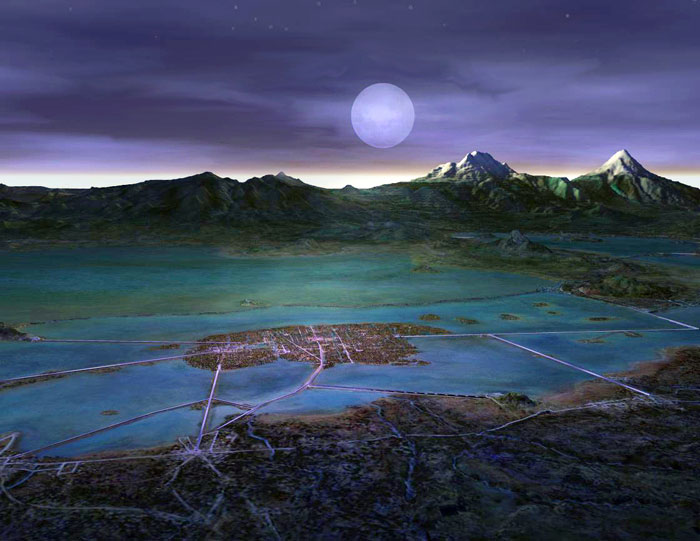Nahua, Aztec, Mexica
As I’ve delved into “Aztec” culture I’ve learned of the many nuances of how the world refers to these people from the Valley of Mexico. Understanding who the Aztecs were takes an understanding of the politics of the Valley. Most Americans think of the Aztecs as Montezuma’s native people that were conquered by Cortes. That concept fits in as a hyper-simplistic footnote to the overall genocide of Indigenous people across North America, a “here’s how THEY did it” anecdote of complicity.
Lost in that simplified narrative is the cultural nuance of Aztec identity and the survival of a “mestizo” culture. Let’s delve in. A familiar European comparison might be the early British Empire, at least for identity structure. Ireland, Scotland and England share the English language. Politically, they are the United Kingdom, three kingdoms united. But if you call an Irishman English he would be quite offended. The people grouped together as Aztecs were also culturally distinct.
Who were the Aztecs?
In the Valley of Mexico most people spoke the Nahuatl language. The cities of Tacuba, Texcoco and Tenochtitlan formed the Triple Alliance, a political entity that dominated Central Mexico. The people of this political alliance are what is most commonly thought of as “Aztec” – the Empire they controlled was shared among the three cities. To ascribe all of Aztec power, accomplishment and cultural richness to Moctezuma’s people is like saying everyone in Ireland, Wales and Scotland is basically English. The word “Aztec” was coined by German scientist Alexander von Humboldt, from the origin story of the Mexica people, who migrated out of the ancestral land of “Aztlan.” Complicated, I know. And as much as it irks some people to use it, Aztec is a convenient to word to describe a large swath of people that were affiliated politically and genetically.
What is Nahuatl?
Nahuatl is a language spoken by the indigenous Nahua people in Mexico and Central America. Nahua people include a diverse range of groups including Texcocans, Cholulans, Tlaxcalans, Mexica and possibly historic people like the Toltecs. Nahuatl is still widely spoken in Mexico, the United States, Guatemala, El Salvador and Belize. Interestingly Nahua is part of the Uto-Aztecan language group which includes Comanche, Shoshoni and Ute, whose name survives as Utah. It’s believed a split in the distant past occurred with the Nahua people migrating south, breaking off from the Northern group.
But what is “Mexica?”
Mexica refers to a specific group of Nahua-speaking people that migrated into the Valley of Mexico in the late 1200s, eventually settling on an island where they founded their capital city of Tenochtitlan. The Mexica had a single leader and were a distinct group from others in the area like the people of Culhuacan or the Chalcas, or like the English and their king were separate from Scotland and their king. In the world of the Triple Alliance, the Mexica city of Tenochtitlan was one of three independent cities in the Alliance, with Tacuba and Texcoco. There was an adjacent island city near Tenochtitlan called Tlatelolco, which is also Mexica. A civil war among the Mexica led to a split and Tlatelolco was established. Eventually Tenochtitlan subjugated their Mexica opponents, effectively uniting the Mexica people again, despite a unique Tlatelolca-Mexica identity.
Was Moctezuma Nahua, Aztec or Mexica?
I would argue Moctezuma was Aztec. WHAT!? I know, that sounds weird, but genetically he probably was not much more Mexica than he was of Culhuacan, Texcoco or any other place on the lake. He was definitely Nahua. Like how European royals mingle their blood and not necessarily from the places they ruled, it was the same with Nahua cities.
I might be out of my depth here, but the ruling class by the time of Moctezuma’s reign were essentially a royal caste that married among the nobility of other cities. The kingdoms switched hands among an interchangeable lineup of royal stock. When the Mexica established Tenochtitlan around 1330, the Tlatoani at that time was probably largely of Mexica blood. By the time Moctezuma was born his DNA had been mingled with royal lineages from Culhuacan and other nearby cities. His brother Cuitlahuac was ruler of the lakeside town of Ixtapalapa, and he would become Tlatoani of the Mexica after Moctezuma’s death. In contrast, the commoners of those towns probably did largely represent a distinct cultural and genetic group, separate from the royal caste. That’s how I see it at least.
And “Mexico?”
In the Aztec era Mexico could refer to any number of things, depending who was speaking and what their knowledge was. It could refer to the merged island cities of Tenochtitlan and Tlatelolco. One could specify they lived in Mexico-Tenochtitlan. But perhaps were of Tlatelolca-Mexica heritage. It could refer generally to the Valley of Mexico. Today Mexico refers to the modern nation with its politics and culture emanating from the former Mexica capital now called Mexico City. It’s important to remember that the Aztecs were just one of many groups that lived in mesoamerica. Millions of Mexicans still speak Maya. Some also speak Tarahumara, Purupecha and others.
What is “mesoamerica,” then, genius?
Mesoamerica refers to a time and place in Mexican/Central American history. Extending from Central Mexico down through Belize, Guatemala and El Salvador and covering a broad range of time from the independent foundation of culture in Mexico through the tail end of the Conquest. It includes historic cultures and places like the Olmec and Teotihuacan, and contemporary cultures, as well as customs, agricultural products, languages and anything else shaped by the people of that time.
Hopefully now when you meet a Nahuatl-speaking Tlatelolca-Mexica from Mexico City, Mexico you’ll know .


